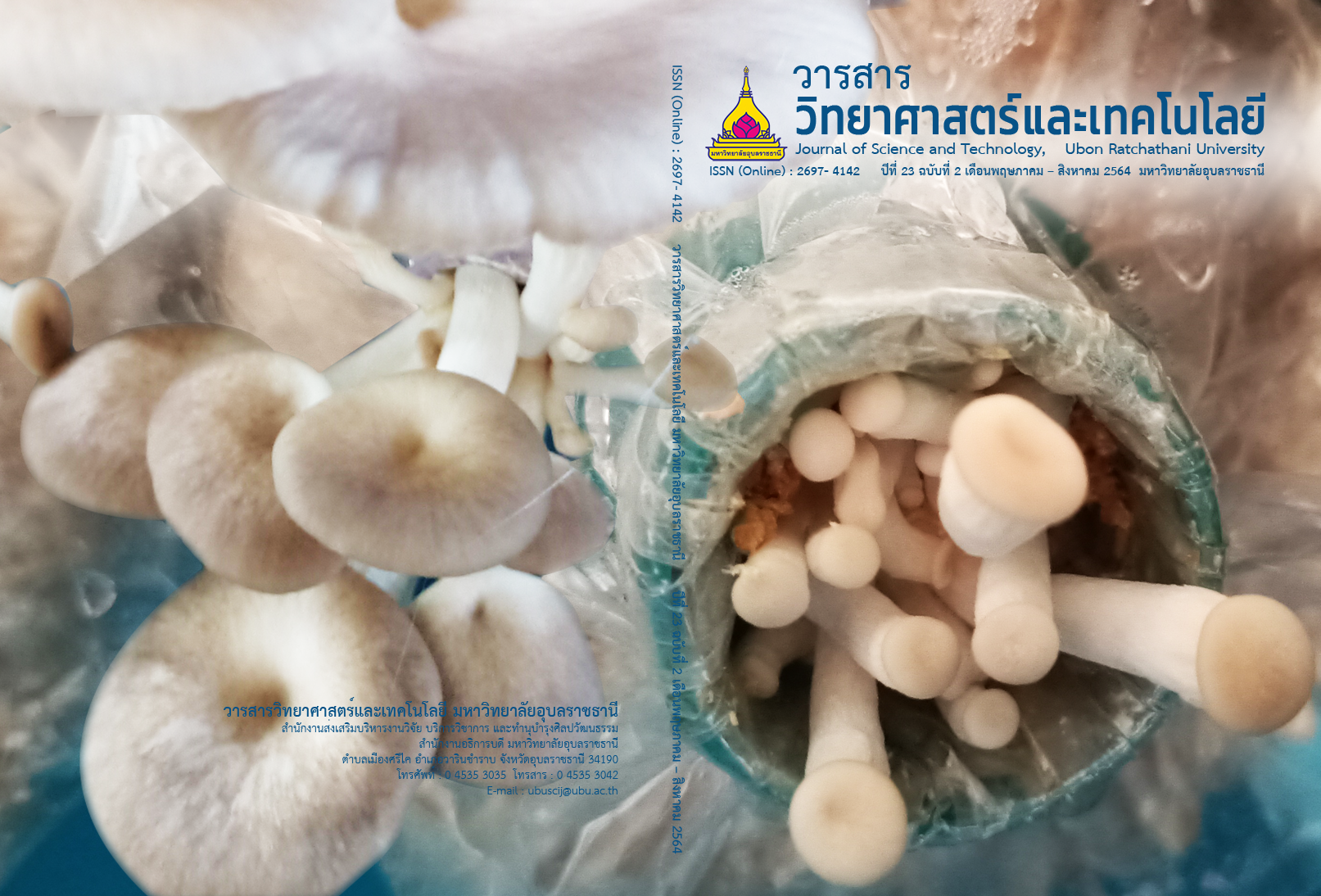ผลของระดับความเค็มต่ออัตราการกินอาหารต่อวันของปูทะเล (Scylla paramamosain)
Main Article Content
บทคัดย่อ
การศึกษานี้มีวัตถุประสงค์เพื่อศึกษาอัตราการกินอาหารของปูทะเล (Scylla paramamosain) ที่ระดับความเค็มต่างกัน โดยเลี้ยงปูในถังไฟเบอร์กลาสขนาด 30×45×30 เซนติเมตร (กว้าง×ยาว×สูง) ที่ระดับความเค็ม 30 20 และ 10 ส่วนในพันส่วน (ppt) ชุดการทดลองละ 3 ซ้ำ ผลการศึกษาพบว่า ปูทะเลที่มีอายุประมาณ 60 วัน (ขนาดความกว้างกระดองเฉลี่ย 9.3±0.7 เซนติเมตร ความยาวกระดอง 6.0±0.5 เซนติเมตร น้ำหนักตัวเฉลี่ย 163.0±54.2 กรัม) ที่เลี้ยงในน้ำความเค็ม 30 20 และ 10 ppt มีอัตราการกินอาหารเฉลี่ยเท่ากับ 3.1±1.6 1.1±0.7 และ1.2±0.7 เปอร์เซ็นต์ต่อน้ำหนักตัวต่อวัน ตามลำดับ ซึ่งไม่มีความแตกต่างกันทางสถิติ (P>0.05) ในทางกลับกัน ปูทะเลที่มีอายุ 120 วัน (ขนาดความกว้างกระดองเฉลี่ย 11.9±0.6 เซนติเมตร ความยาวกระดอง 8.1±0.6 เซนติเมตร น้ำหนักตัวเฉลี่ย 347.5±47.6 กรัม) ที่เลี้ยงในความเค็ม 30 ppt มีอัตราการกินอาหารเฉลี่ยเท่ากับ 5.6±3.1 เปอร์เซ็นต์ต่อน้ำหนักตัวต่อวัน ซึ่งสูงกว่า (P<0.05) ที่เลี้ยงในน้ำความเค็ม 20 และ 10 ppt ที่มีอัตราการกินอาหารเฉลี่ยเท่ากับ 1.0±0.6 และ 0.6±0.2 เปอร์เซ็นต์ต่อน้ำหนักตัวต่อวัน ตามลำดับ การศึกษานี้ชี้ให้เห็นว่า ระดับความเค็มของน้ำมีผลต่ออัตราการกินอาหารของปูทะเล โดยเฉพาะปูที่มีอายุหรือขนาดเพิ่มขึ้น
Article Details
บทความที่ได้รับการตีพิมพ์เป็นลิขสิทธิ์ของ วารสารวิทยาศาสตร์และเทคโนโลยี มหาวิทยาลัยอุบลราชธานี
ข้อความที่ปรากฏในบทความแต่ละเรื่องในวารสารวิชาการเล่มนี้เป็นความคิดเห็นส่วนตัวของผู้เขียนแต่ละท่านไม่เกี่ยวข้องกับมหาวิทยาลัยอุบลราชธานี และคณาจารย์ท่านอื่นๆในมหาวิทยาลัยฯ แต่อย่างใด ความรับผิดชอบองค์ประกอบทั้งหมดของบทความแต่ละเรื่องเป็นของผู้เขียนแต่ละท่าน หากมีความผิดพลาดใดๆ ผู้เขียนแต่ละท่านจะรับผิดชอบบทความของตนเองแต่ผู้เดียว
เอกสารอ้างอิง
[2] Thepphanich A. and et al. 2015. Culture of mud crab (Scylla paramamosain Estampador,1949). (Technical Paper 6/2018). Fishery department, Bangkok, Thailand. (in Thai)
[3] Fishery department. 2018. Fishery statistics of Thailand 2018. Fishery department, Bangkok, Thailand. (in Thai)
[4] Ratanachote A. and et al. 2014. Culture of mud crab. Fishery department, Bangkok, Thailand. (in Thai)
[5] Rahi Md. L. and et al. 2020. Impact of salinity changes on growth, oxygen consumption and expression pattern of selected candidate genes in the orange mud crab (Scylla olivacea). Aquaculture Research 51(10): 4290-4301.
[6] Tangkrock-olan N. and Thongtiam K. 2010. Effects of salinity and nitrite on hemolymph osmolality and nitrite uptake of hemolymph of white- leg shrimp, Litopenaeus vannamei Boone, 1931. Burapha Science Journal. 15: 20-28 (in Thai)
[7] Legeay, M., & Massabuau, J. C. (2000). Effect of salinity on hypoxia tolerance of resting green crabs, Carcinus maenas, after feeding. Marine Biology 136: 387–39
[8] McGaw, I. J., & Naylor, E. (1992). Salinity preference of the shore crab Carcinus maenas in relation to coloration during intermolt and to prior acclimation. Journal of Experimental Marine Biology and Ecology 155(2): 145– 159.
[9] Oniam V., Arkronrat W. and Wechakama T. 2020. Feed intake and survival rate assessment of blue swimming crab (Portunus pelagicus) raised in earthen pond. Journal of Agriculture. 28: 83-91. (in Thai)
[10] Nhoorit K. 2013. Nile tilapia cage culture in Ubon Ratchathani 2013. Fisheries Economics, Fishery department. (in Thai)
[11] Chutjareyaves S. 2001 Cost and return of sex-reversed nile tilapia cage culture in Moon River in Ubon Ratchathani. In: Proceedings of the 39th Kasetsart University Annual Conference of Fisheries Agro-Industry, 5-7 Feb 2001. Kasetsart University, Thailand. (in Thai)
[12] Eriegha, O. J. and Ekokotu, P. A. 2017. Factors affecting feed intake in cultured fish species: A review. Animal Research Interbational. 14(2): 2697-2709.p
[13] APHA, AWWA and WEF. 2017. Standard methods for the examination of water and wastewater. 23rd ed. American Public Health Association, Washington.
[14] Jantrarotai W. and Setasith P. 1997. Proportion of Protein from Fish meal and Soybean meal at the lowest level doesn’t have effect on growth. Utilization of food and feeding rate of hybrid catfish. (Technical Paper 4/1997). Fishery department, Bangkok, Thailand. (in Thai)
[15] Normant M., Król M. and Jakubowska M. 2012. Effect of salinity on the physiology and bioenergetics of adult Chinese mitten crabs Eriocheir sinensis. Journal of Experimental Marine Biology and Ecology 416-417: 251-220.
[16] Pisamayarom K. and Phadasri S. 2020. The effect of calcium on the growth and molting of rice field crab. Agricultural Science Journal 51(1): 443-448. (in Thai)
[17] Pratoomchat B. 2014. Physicochemical and digestive enzyme activities changes of blue swimming crab (Portunus pelagicus) over molt cycle. Burapha University, Chon Buri, Thailand. (in Thai)
[18] Pattarapanyavong N., Jorrakate W. and Promruksa P. 2019. Effect of culture of mud crab (Scylla spp.) in cement pond and the attractiveness of investment intensive culture of mud crab in single box. In: Proceedings of the 11th Walailak Procedia Conferrence of Walailak University, 27-28 Mar 2019. Nakhon Si Thammarat, Thailand. (in Thai)
[19] Koedprang W., Phetchaiya T. and Khakhong S. 2017. Effect of water salinity on survival rate and growth performances of mole crab (Emerita emeritus Linn. 1767). Rajamangala University of Technology Srivijaya Research 9: 14-23. (in Thai)
[20]Staples, D.J. and Heales, D.S. 1991. Temperature and salinity optima for growth and survival of juvenile banana prawn Penaeus merguiensis. Journal of Experimental Marine Biology and Ecology 154(2): 251-274.
[21] Romano N. and Zeng C. 2006. The effects of salinity on the survival, growth and haemolymph osmolality of early juvenile blue swimmer crabs, Portunus pelagicus. Aquaculture 260(1-4): 151-162.
[22] Jitnarong M. N. and Sudtongkong C. 2014. Effect of Salinity on egg-bearing development of sesarmid crab (Episesarma singporense Tweedie, 1936). In: Proceedings of the 4th Marine Science Conferrence of Prince of Songkla University, 10-12 Jun 2014. Songkla, Thailand. (in Thai)
[23] Yuan Q. and et al. 2017. Effects of water temperature on growth, feeding and molting of juvenile Chinese mitten crab Eriocheir sinensis. Aquaculture 468(1): 169-174.
[24] Wyban J., Walsh W. A. and Godin D. M. 1995. Temperature effects on growth, feeding rate and feed conversion of the Pacific white shrimp (Penaeus vannamei). Aquaculture 138: 267-279.
[25] Fishery department. 2008. Water quality for coastal aquaculture. Fishery department, Bangkok, Thailand. (in Thai)
[26] Yan M. and et al. 2004. Effects of salinity on food intake, growth, and survival of pufferfish (Fugu obscurus). Journal of Applied Ichthyology 20(2): 146-149.
[27] Luz. R.K. and et al. 2008. Growth, food intake regulation and metabolic adaptations in goldfish (Carassius auratus) exposed to different salinities. Aquaculture 276: 171-178.


